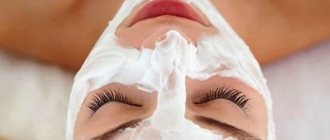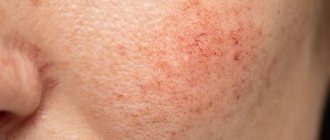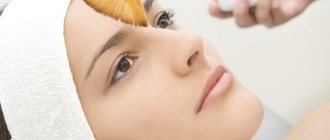The upper layers of the skin are represented by a porous epidermis, which must be regularly renewed. The rate of renewal decreases with age and under the influence of unfavorable factors. As a result, particles of the epidermis layer on top of each other, begin to clog pores and can provoke the proliferation of pathogenic microorganisms.
To regularly cleanse the skin at home, many people choose chemical peels with acids. They dissolve the upper dead layer of cells, restoring cellular nutrition and respiration. At home, you can also use mechanical peelings with exfoliating microparticles. You can also cleanse your facial skin with professional cleansing. It is performed by an experienced cosmetologist. Highly concentrated acids are also used only in professional products that are available to beauty salon specialists or dermatologists.
Which is better: chemical peeling or facial cleansing?
Peeling with acid and facial cleansing (mechanical, ultrasonic, vacuum) are considered effective methods that solve specific problems and tasks. It is worth choosing the procedure recommended by the cosmetologist.
Ultrasonic facial cleansing helps to get rid of the following skin problems in one procedure:
- black dots;
- increased greasiness, greasy shine;
- extra layer of epidermis;
- surface contamination.
Facial cleansing does not have a significant traumatic effect on the skin. The method is used mainly in the initial stage of acne, when there are comedones, which are easy to get rid of mechanically or using ultrasound, vacuum and other similar methods.
And acid peeling, especially highly concentrated, can damage the deeper layers of the skin, but it also solves other important problems:
- dark spots;
- post-acne;
- small scars;
- enlarged pores;
- small wrinkles.
The cosmetologist selects a concentration of acid that can safely but effectively solve cosmetic problems that cannot be dealt with, for example, ultrasonic facial cleansing.
https://youtu.be/https://www.youtube.com/watch?v=p4PM_I5Es_A
Patient reviews
Patients have a positive attitude towards exfoliation. Many people choose this method of deep skin cleansing. Opinions about mechanical sanitation of pores are often negative. Patients see the procedure as a temporary solution to the problem, but at the risk of worsening the situation.
Opt for peeling.
The patient does not approve of regular cleanings and advises establishing daily care.
Features of chemical peeling
Chemical peeling is a method of cleansing and rejuvenation using acids of a certain concentration. During the procedure, the upper layers of the epidermis and dermis are destroyed, but to a controlled depth. Along with the removed tissues, facial wrinkles, age spots, post-acne and other skin imperfections disappear.
The choice of a specific type of chemical peel depends on the characteristics of the skin, the age of the patient, and the presence of certain dermatological problems. The procedure takes place in several stages. For medium and deep chemical peeling, the specialist first carries out pre-peel preparation, which consists of treating the skin with a weakly concentrated acid solution for 5-7 days. This will prepare the tissue for contact with a specific chemical agent.
The peeling itself begins with cleansing the facial skin and removing residual sebaceous secretions. The specialist applies the product in an even layer and monitors the tissue reaction. After a certain time, the acid is neutralized with a special composition.
Hyperemia and moderate swelling are a natural reaction to contact with a chemical substance. On the first day, a feeling of tightness appears, and areas with pronounced peeling appear. The damaged keratinized layer of the epidermis gradually exfoliates, and smooth and youthful skin forms underneath.
Indications and contraindications
Chemical peeling can be done at any age, but experts recommend carrying out the procedure starting from 25-30 years old. The cosmetologist will select a certain concentration of acid, which should solve existing dermatological problems.
General indications for the procedure:
- sagging skin, wrinkles;
- post-acne;
- hyperpigmentation;
- increased skin greasiness;
- lack of moisture and elasticity.
The chemical peeling procedure should be abandoned in case of exacerbation of any infectious and inflammatory processes, in the presence of open lesions and neoplasms, rosacea, trigeminal neuralgia, pregnancy, and oncological diseases.
How to treat acne and acne
This problem definitely needs to be treated.
If acne gets too bad, you can get a large number of scars that cannot be removed. First of all, you need to consult a cosmetologist. He will examine you, study the problem, and determine the severity of the problem. Treatment will depend on how advanced the acne is, what age the patient with acne and acne is, and what kind of skin the patient has. After consultation with a cosmetologist, he will determine how to treat this problem. When treating acne, cosmetologists use only certified and reliable cleaning and peeling devices.
All devices are approved by the World Health Organization and are approved for use in cosmetology clinics. Cosmetologists use the latest equipment that keeps pace with progress.
There are a lot of ways to get rid of acne and acne, but mainly it is facial cleansing and various peelings.
Ultrasonic peeling is used. This is the latest technology that helps remove dead skin cells from the skin, remove everything, even deep impurities, and cleanse the skin of fat and sebaceous plugs. This peeling also effectively gets rid of comedones and acne. Although ultrasonic peeling is very effective, it only affects the very top layer of skin. Working with this layer is enough to effectively cleanse the pores and make the skin as smooth, clean, and beautiful as possible. Ultrasonic peeling is used mainly for those whose pores are only superficially contaminated and whose acne is not severe. For people with severe acne, other treatments are available.
Ultrasonic peeling helps make blood circulation faster, due to this the skin is well moisturized without the use of special products. The density of the dermis increases greatly, the skin becomes much younger. Facial muscles become more toned, ultrasonic peeling gives the effect of a good facial massage. The skin becomes more saturated with oxygen, making it look much younger.
Often, various medications are also used in combination with ultrasonic peeling. This is called ultrasound therapy. With the help of this therapy, acne goes away, inflammation disappears, and the epidermis is greatly moisturized. The protective layer is restored.
Cleansing is also very effective in getting rid of acne and acne. Of course, you can do facial cleansing yourself, at home. However, this will only make it worse and harm your skin. You can greatly aggravate the situation, the acne will spread much more. If cleaning is carried out by professionals, then as a result you will get a healthy and as smooth as possible dermis.
Features of facial cleansing
Facial skin cleansing can be ultrasonic, vacuum, manual, and each method has its own characteristics and indications. Before the procedure, it is necessary to thoroughly clean the skin of cosmetics and impurities and steam and loosen the stratum corneum. Many cosmetologists use a special warming gel, which helps open clogged pores.
Facial cleansing is contraindicated for people with sensitive, thin and dry skin, dilated vascular walls, bronchial asthma, herpes, eczema and other infectious and allergic skin diseases. It is not recommended to carry out the procedure before or during menstruation, since during this period the skin is prone to allergic and inflammatory reactions.
After cleansing, the facial skin is treated with a special lotion. Then a professional cosmetologist begins to cleanse the pores, removing the thin film of fat covering the epidermis, dead cells and black comedones. In this case, special lighting is used to improve visibility.
In case of multiple comedones and pore contamination, the procedure can be carried out in only a few sessions. In advanced cases, facial cleansing is combined with darsonvalization and vacuum procedures.
At the final stage, the facial skin is disinfected with lotions and tonics, which help narrow pores and relieve redness. For these purposes, infrared radiation and clay-based cosmetic masks are also used. Healing clay has the ability to absorb excess sebum, relieve inflammation, cleanse and tighten enlarged pores. After the procedure, the skin of the face acquires a healthy color, and the pores become barely noticeable. But within a few days there is obvious hyperemia and peeling, and itching may occur.
Mechanical cleansing of the face if sterility is not maintained can lead to the development of an infectious process, inflammation, or the addition of a secondary infection, therefore such a cosmetic procedure should be carried out only in a specialized beauty salon or beauty salon.
It is forbidden to wash your face for 24 hours after the procedure. It is also not recommended to use alcohol-containing lotions and tonics for several weeks, or visit solariums and public beaches. The skin after such a traumatic procedure needs rest and protection. If crusts appear after mechanical cleaning, do not open or remove them under any circumstances, otherwise scars will appear in their place.
Is it possible to combine?
Peeling and cleansing have different effects on the skin, and experts say that these procedures can be combined. They will not only complement each other, but will also allow you to achieve maximum efficiency.
Before combining procedures, it is recommended to consult with a qualified cosmetologist who will tell you the order of their implementation. Both cosmetic procedures, despite their differences, can heal and cleanse the skin, making it younger and fresher. To choose the best method for yourself, do not forget to consult a specialist.
Recovery period
The more the skin is damaged, the longer it takes to recover. When concentrated acids are used during chemical peeling, tissues are severely damaged, but thanks to such deep damage, it is possible to get rid of many imperfections, including post-acne and hyperpigmentation. In the first 2 weeks after the procedure, active peeling of the skin occurs. The cosmetologist prescribes regenerating and anti-inflammatory drugs.
If deep phenol peeling is carried out, then for three days after it any contact with water is prohibited. Drinking is only allowed through a straw. You can wash your face only after the red skin is covered with a fibrin coating, which indicates the beginning of the recovery process. It can take more than 2 months.
But classic acid peels, which affect the superficial layers of the epidermis, do not require such a long recovery. For the first 5-7 days, the skin may remain hyperemic and inflamed. During this period, visits to baths, saunas, and sunbathing are prohibited. You should also avoid sports training, intense physical activity, and visiting the pool.
Recovery after facial cleansing takes several days. After mechanical cleansing, the face may remain red for 2-3 hours. During this period, you should not wash your face with water, use cosmetics, sunbathe, or go to the bathhouse. Ultrasonic facial cleansing takes place without discomfort and does not require long-term recovery.
Combination rules
Many patients are interested in whether it is possible to do both cleansing options at once. According to ordinary people, this will bring a double positive effect.
Cosmetologists do not recommend performing both procedures at the same time. The best option: preliminary preparation of the skin using cosmetics with a slight exfoliation effect. It is acceptable to exfoliate using products with minimal acid content, right before cleansing.
Perform standard professional peeling (acid concentration 20–50%) with any depth of impact, it is recommended at intervals of 1–4 weeks before or after cleansing. More precisely, the gap interval will be determined by a cosmetologist.
Attention! There is an option to “close” the cleaning with peeling. Cosmetologists use light acid preparations. Exfoliation is not done if the integrity of the tissue is damaged. Mechanical cleansing of pores is not performed if the stratum corneum is excessively thick and covers the ducts.
The doctor can prescribe the sequence of procedures. If the pores are excessively clogged, it is recommended to first clean them, after healing, and if there is no inflammation, peel them. If the skin is excessively thickened and dehydrated, then it is better to initially choose peeling.
What cosmetic procedures can be combined with?
Carbon peeling goes well with other types of hardware cosmetology: fractional thermolysis, laser biorevitalization, plasma lifting, etc.
The effect is especially pronounced when combined with fractional thermolysis, which creates favorable conditions in the deep layers of the skin for the synthesis of collagen and elastin proteins. This contributes to a more pronounced rejuvenating effect.
You can look beautiful and young without discomfort and side effects in the form of complications. Laser carbon peeling is a safe and effective treatment and skin rejuvenation. After completing the procedure, you will understand that you can look absolutely perfect without complications or disappointments!
Be careful: medical contraindications
If the decision is made, carefully read the following list of medical contraindications.
Cleaning should not be carried out under any circumstances:
- In the presence of fungal, inflammatory, viral and infectious diseases on the face, unless they are cured before starting the procedure;
- If there are severe diseases of internal organs and any neoplasms (this also applies to peeling);
- If you have rosacea, trichosis, herpes and cheilitis;
- With increased fragility of blood vessels.
- If you have temporary health problems. You can learn about peeling with calcium chloride in this article.
Peeling is contraindicated in the following cases:
- During pregnancy and breastfeeding;
- For viral diseases accompanied by high temperature, in particular fever;
- For pustular diseases on the skin and herpes;
- For any cancer;
- .For serious diseases of the cardiovascular system;
- For allergic diseases or allergies to certain substances.











